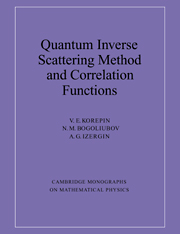Book contents
- Frontmatter
- Contents
- Preface
- Part I The Coordinate Bethe Ansatz
- Part II The Quantum Inverse Scattering Method
- Part III The Determinant Representation for Quantum Correlation Functions
- Introduction to Part III
- IX Scalar Products
- X Norms of Bethe Wave Functions
- XI Correlation Functions of Currents
- XII Correlation Function of Fields
- Part IV Differential Equations for Quantum Correlation Functions
- Final Conclusion
- References
- Index
Introduction to Part III
Published online by Cambridge University Press: 04 August 2010
- Frontmatter
- Contents
- Preface
- Part I The Coordinate Bethe Ansatz
- Part II The Quantum Inverse Scattering Method
- Part III The Determinant Representation for Quantum Correlation Functions
- Introduction to Part III
- IX Scalar Products
- X Norms of Bethe Wave Functions
- XI Correlation Functions of Currents
- XII Correlation Function of Fields
- Part IV Differential Equations for Quantum Correlation Functions
- Final Conclusion
- References
- Index
Summary
The algebraic Bethe Ansatz is a powerful method for the calculation of quantum correlation functions. In Part III we shall start this calculation. We shall arrive at an extremely important conclusion: quantum correlation functions can be represented as determinants of certain matrices. The dimension of these matrices is equal to the number of particles in the ground state. In order to better understand the nature of this matrix, one should look once more through section 6 of Chapter VI and section 10 of Chapter VII, where the determinant representation of the partition function for the six-vertex model with a special type of boundary conditions (domain wall) was obtained. Starting from determinant formulæe (VII.10.1) and (VII.10.2) and using also the formula for the determinant of the sum of two matrices (in the Appendix to Chapter IX), one can reproduce all the determinant formulæe in Part III. In the thermodynamic limit, the correlation functions will be represented as determinants of a Predholm integral operator. In Part IV, we shall explain how to use this determinant representation to write down the differential equation for a quantum correlation function. In Part IV we shall also discover that the differential equation for a quantum correlation function is closely related to the initial classical nonlinear differential equation, which was quantized (in our example this is the nonlinear Schrödinger equation). The quantum correlation functions play the role of the τ functions of a classical differential equation.
- Type
- Chapter
- Information
- Quantum Inverse Scattering Method and Correlation Functions , pp. 189 - 192Publisher: Cambridge University PressPrint publication year: 1993



